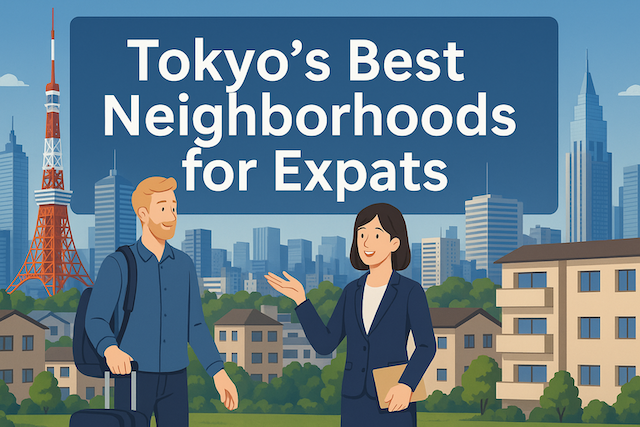Tokyo’s Best Neighborhoods for Expats

Contents
- Tokyo’s Best Neighborhoods for Expats
- 1. Minato Ward: International and Upscale
- 2. Shibuya Ward: Trendy, Central, and Youthful
- 3. Setagaya Ward: Residential and Family-Oriented
- 4. Meguro Ward: Calm and Convenient
- 5. Koto Ward: Modern Developments and Waterfront Living
- 6. Chiyoda Ward: Prestige and Central Access
- 7. Bunkyo Ward: Education Hub
- 8. Taito Ward: Culture and Affordability
- 9. Nerima and Itabashi Wards: Affordable Suburban Living
- 10. Toshima Ward: Diverse and Connected
- Key Factors to Consider When Choosing a Neighborhood
- Renting Tips for Expats
- Final Thoughts
- Frequently Asked Questions
- What are the best neighborhoods in Tokyo for expat families?
- Which areas are most foreigner-friendly in Tokyo?
- Is it expensive to live in Tokyo?
- Can I rent an apartment in Tokyo without speaking Japanese?
- What documents do I need to rent an apartment in Tokyo?
- How much is the average rent in Tokyo?
- What is “key money” and do I have to pay it?
- Which neighborhoods have access to international schools?
- Is it better to live near my workplace or in a quieter area?
- Are furnished apartments available in Tokyo?
- What’s the best area in Tokyo for a single expat or digital nomad?
- How far in advance should I start apartment hunting?
Tokyo’s Best Neighborhoods for Expats
Moving to Tokyo is an exciting journey—but choosing the right neighborhood can make all the difference in your daily experience. With over 14 million residents and dozens of unique districts, Tokyo offers something for everyone: vibrant nightlife, quiet suburbs, international schools, modern condos, and historic charm.
This guide explores the best neighborhoods for expats living in Tokyo. Whether you’re relocating for work, education, or adventure, this article will help you find the right fit for your lifestyle.
1. Minato Ward: International and Upscale
Minato-ku is home to many embassies, multinational companies, and luxurious residences, making it a top choice for foreign professionals and diplomats.
Highlights:
-
Roppongi: Known for nightlife, expat-friendly bars, embassies, and high-rise apartments. The Roppongi Hills and Tokyo Midtown complexes offer modern living and shopping.
-
Azabu-Juban: A cozy neighborhood with traditional shops, international preschools, and easy access to Roppongi and Hiroo.
-
Hiroo: One of the most popular areas among Western expats. Hiroo features quiet residential streets, leafy parks, and proximity to international schools like The International School of the Sacred Heart and Nishimachi International School.
Ideal for:
-
Diplomats
-
Corporate executives
-
Families needing access to international schools
2. Shibuya Ward: Trendy, Central, and Youthful
Shibuya is famous for its energy and youth culture, but it also includes quieter areas that are great for expats looking for a central location with a modern vibe.
Highlights:
-
Daikanyama: A stylish, upscale area with boutique shopping, chic cafés, and a European village feel.
-
Ebisu: Offers a sophisticated yet relaxed atmosphere with high-end dining and easy access to the JR Yamanote Line.
-
Yoyogi/Uehara: Residential and green, with family-friendly vibes and direct access to Shinjuku and Shibuya. Close to Yoyogi Park, one of Tokyo’s largest open spaces.
Ideal for:
-
Young professionals
-
Singles and couples
-
Creative professionals
3. Setagaya Ward: Residential and Family-Oriented
Setagaya is one of Tokyo’s most desirable residential wards, especially for families looking for space, parks, and a slower pace of life.
Highlights:
-
Futako-Tamagawa: A modern riverside area with luxury shopping, green spaces, and international supermarkets.
-
Yoga/Sangenjaya: Trendy but more relaxed than central Shibuya; popular with young families and creative professionals.
-
Shimokitazawa: A quirky, artsy neighborhood known for vintage shops, live music, and a bohemian vibe. Good for younger expats.
Ideal for:
-
Families
-
Remote workers
-
People seeking a quieter, lifestyle-focused Tokyo experience
4. Meguro Ward: Calm and Convenient
Meguro strikes a perfect balance between accessibility and calm, offering leafy streets and stylish low-rise housing. It’s a favorite among long-term expats who want a peaceful environment without sacrificing convenience.
Highlights:
-
Nakameguro: Chic cafés, riverside cherry blossoms, and boutique shopping make it a favorite for creative expats.
-
Meguro Station area: Offers direct train access to key city hubs, along with solid dining and local community charm.
Ideal for:
-
Creatives and designers
-
Couples and small families
-
Those seeking a walkable, scenic neighborhood
5. Koto Ward: Modern Developments and Waterfront Living
Koto-ku has undergone massive redevelopment over the past two decades, offering modern apartments, shopping centers, and scenic views along Tokyo Bay.
Highlights:
-
Toyosu: Home to the famous Toyosu Fish Market and LaLaport shopping center. The area is full of family-friendly, modern condo towers.
-
Kiba and Monzen-Nakacho: Quieter areas with parks, local temples, and a mix of new developments and traditional charm.
Ideal for:
-
Families wanting modern housing
-
Budget-conscious expats who still want comfort
-
Those who work in the Odaiba or Tokyo Bay area
6. Chiyoda Ward: Prestige and Central Access
As the home of the Imperial Palace, government buildings, and major business districts, Chiyoda is at the heart of Tokyo—both geographically and symbolically.
Highlights:
-
Akasaka: A major business district close to Nagatacho and Kasumigaseki (political centers). Ideal for professionals working in government or consulting.
-
Iidabashi: A central transport hub with good connections, French schools nearby, and riverside parks.
Ideal for:
-
Professionals in government or finance
-
Expats needing walkable access to city centers
-
French-speaking families (proximity to Lycée Français International de Tokyo)
7. Bunkyo Ward: Education Hub
Bunkyo-ku is known as Tokyo’s academic center, with many universities and private schools. It offers a mix of residential calm and intellectual energy.
Highlights:
-
Hongo: Near the University of Tokyo, with a student-friendly, international feel.
-
Mejiro and Gokokuji: Residential, green, and peaceful, with convenient train access.
Ideal for:
-
Exchange students
-
University staff and researchers
-
Families seeking quieter central neighborhoods
8. Taito Ward: Culture and Affordability
Taito offers a glimpse of “old Tokyo” with its traditional shopping streets, historic temples, and affordable housing. It’s perfect for those on a budget or interested in culture.
Highlights:
-
Asakusa: Famous for Sensoji Temple and Nakamise-dori. A strong sense of Japanese tradition and lower rent prices.
-
Ueno: Home to Ueno Park, museums, and Ueno Zoo. Good transportation and local charm.
Ideal for:
-
Budget-conscious expats
-
Cultural explorers
-
Artists and students
9. Nerima and Itabashi Wards: Affordable Suburban Living
These western wards are less central but more affordable and spacious, making them suitable for families or long-term residents.
Highlights:
-
Ekoda (Nerima): Home to multiple universities, small-town feel, lower cost of living.
-
Ooyama (Itabashi): Family-oriented, safe, and filled with local shopping streets.
Ideal for:
-
Families seeking value
-
Students
-
Retirees or long-term residents
10. Toshima Ward: Diverse and Connected
Toshima offers affordability with great train access. It’s one of the most international wards, with a diverse population and educational opportunities.
Highlights:
-
Ikebukuro: A major shopping and entertainment hub with direct lines to almost every part of Tokyo. Proximity to international schools and a vibrant Chinatown.
-
Mejiro and Zoshigaya: Calmer residential options near Ikebukuro.
Ideal for:
-
First-time Tokyo residents
-
Those without cars who rely on trains
-
Budget travelers and short-term workers
Key Factors to Consider When Choosing a Neighborhood
International Schools
If you have school-aged children, proximity to an international school can be a top priority. Hiroo, Minato, Setagaya, and Chiyoda have good access to such institutions.
Commuting Distance
Tokyo’s rail network is among the best in the world—but living near your workplace still improves your quality of life. Consider commuting time carefully.
Cost of Living
Central neighborhoods (Minato, Shibuya, Chiyoda) are more expensive, while outer wards (Nerima, Itabashi, Taito) are more affordable. Your housing budget will play a major role.
Lifestyle Preferences
Do you want nightlife? Quiet parks? Trendy cafés? Choose based on your hobbies and personality, not just proximity.
Renting Tips for Expats
-
Use English-friendly agencies: Expat-focused realtors like Japan Home Search or Tokyo Rent offer bilingual services.
-
Consider furnished apartments: Short-term leases or serviced apartments can be convenient if you’re new to Japan.
-
Guarantor requirements: Many leases require a Japanese guarantor or guarantor company. Be sure to ask upfront.
-
Key money and deposits: It’s common to pay 2–4 months of rent upfront in deposits, insurance, and key money (礼金).
Final Thoughts
Tokyo is a city of endless contrasts—modern and traditional, fast-paced and serene. As a foreigner, your choice of neighborhood will deeply shape your experience. Whether you’re seeking the luxury of Minato, the charm of Bunkyo, or the creativity of Nakameguro, there’s a corner of Tokyo that can feel like home.
Take time to visit different areas, explore the side streets, and imagine your daily routine there. When the vibe feels right—you’ll know.
Related Articles (Suggestions for Internal Linking)
-
How to Rent an Apartment in Tokyo as a Foreigner
-
Tokyo’s Top International Schools
-
Budgeting Your First Year in Tokyo
-
Working Remotely from Japan: Digital Nomad Tips
-
Expat Communities in Tokyo You Should Know
Frequently Asked Questions
What are the best neighborhoods in Tokyo for expat families?
Setagaya, Meguro, and Minato (especially Hiroo and Azabu-Juban) are top picks for families, thanks to their safe streets, green spaces, and access to international schools.
Which areas are most foreigner-friendly in Tokyo?
Hiroo, Roppongi, and Daikanyama are considered very foreigner-friendly, offering bilingual services, international supermarkets, and a high concentration of expats.
Is it expensive to live in Tokyo?
It depends on the neighborhood. Central areas like Minato and Shibuya are more expensive, while places like Nerima, Itabashi, and Taito offer more affordable rent options.
Can I rent an apartment in Tokyo without speaking Japanese?
Yes. Many real estate agencies specialize in serving foreigners and offer English-speaking support. Some properties are labeled as “foreigner-friendly.”
What documents do I need to rent an apartment in Tokyo?
You’ll typically need a residence card, passport, proof of income or employment, and sometimes a Japanese guarantor or guarantor company.
How much is the average rent in Tokyo?
Studio apartments range from ¥70,000 to ¥130,000/month depending on the location. Family-sized units in central Tokyo can exceed ¥300,000/month.
What is “key money” and do I have to pay it?
Key money (礼金) is a non-refundable payment to the landlord, often equivalent to one month’s rent. Some modern or foreigner-focused properties waive this fee.
Which neighborhoods have access to international schools?
Minato (Hiroo, Azabu), Setagaya, and Chiyoda Wards are home to many international schools, including British, American, German, and French institutions.
Is it better to live near my workplace or in a quieter area?
It depends on your priorities. Central locations reduce commute time, but quieter neighborhoods like Setagaya and Meguro offer better quality of life for families and remote workers.
Are furnished apartments available in Tokyo?
Yes. Short-term serviced apartments and monthly rentals often come furnished. Standard leases (2-year contracts) usually offer unfurnished units.
What’s the best area in Tokyo for a single expat or digital nomad?
Ebisu, Nakameguro, and Daikanyama are great for singles and nomads—offering trendy cafés, walkable streets, and good access to coworking spaces.
How far in advance should I start apartment hunting?
Start 4–6 weeks before your intended move-in date. Most apartments become available 1 month prior to vacancy, and the rental process moves quickly.




